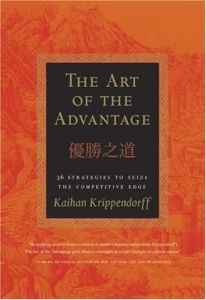Join getAbstract to access the summary!

Join getAbstract to access the summary!
Kaihan Krippendorff
The Art of the Advantage
36 Strategies to Seize the Competitive Edge
Thomson Texere, 2003
What's inside?
The time-tested strategies of the Chinese classic, The 36 Stratagems, light the path to long-term business victories.
Recommendation
Author Kaihan Krippendorff, an expert on Sun Tzu and Chinese military strategy, applies the Chinese classic The 36 Stratagems to modern business thinking. Individually, the stratagems are rarely a revelation - the case studies show that many corporations already utilize them - but the larger point, that Eastern or Taoist thinking offers new options for the Western business strategist, is very useful and offers a real paradigm shift. Some of the stratagems need more discussion, and the connection between some stratagems and their accompanying case studies is shaky, but this is an excellent introduction to a neglected classic. Its strategies (an ethical minefield if you take them too literally) are not limited to battlefields or businesses. getAbstract recommends this book to business strategists, policymakers and those struggling with competition. It is also valuable for anyone working in or facing competition from East Asia, where these stratagems are already well known and widely used.
Summary
About the Author
A longtime student of Eastern philosophy, Kaihan Krippendorff earned his M.B.A at Columbia University and a bachelors in finance and engineering from the University of Pennsylvania’s School of Engineering and Wharton Business School. He has worked at McKinsey & Company, Deloitte Consulting, Matsumoto Group and Calhoun Baker.


















Comment on this summary